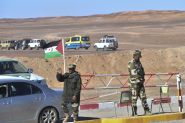- Home
- Middle East
- Morocco: The Symbolic Weight of the 50th Anniversary of the Green March

©ABDEL MAJID BZIOUAT/AFP
This November 6, Morocco is marking the fiftieth anniversary of the Green March, a commemoration that carries particular symbolic weight this year, just days after the UN Security Council adopted a new resolution on October 31, 2025. The resolution describes Morocco’s autonomy plan for Western Sahara as “a serious and credible basis” for a lasting political solution.
Drafted under U.S. leadership, the text calls on the parties concerned to resume negotiations based on the plan presented by Rabat in 2007, which proposes autonomy for Western Sahara under Moroccan sovereignty. Washington, which recognized Moroccan sovereignty over the Sahara in 2020 as part of the Abraham Accords, maintains that this plan offers the most realistic path forward.
A few days after the vote, King Mohammed VI announced that October 31 would become a new national holiday, in tribute to what he described as a “landmark stage and a decisive turning point in the history of modern Morocco.” The decision echoes that of his father, King Hassan II, who launched the Green March on November 6, 1975 -which is also observed as a national holiday.
A Founding Moment in Morocco’s History
At the time, Western Sahara had been under Spanish occupation for over a century. In the context of decolonization, Spain, backed by the United Nations, was considering organizing a referendum on self-determination. Morocco, meanwhile, claimed the territory as an integral part of the kingdom, citing historical ties of allegiance between certain Sahrawi tribes and the Sherifian monarchy.
In October 1975, upon Morocco’s request, the International Court of Justice (ICJ) issued an advisory opinion acknowledging the existence of these historical ties but concluding that “the materials and information presented to it do not establish any tie of territorial sovereignty between the territory of Western Sahara on the one hand and the Kingdom of Morocco or the Mauritanian entity on the other.”
In a climate of rising tension, King Hassan II called for a “peaceful crusade” toward the territory to reaffirm Morocco’s claim over Western Sahara. Nearly 350,000 Moroccans responded, marching peacefully to the border carrying only the Quran and the national flag, supported logistically by the state and the Moroccan army.
This show of force pushed the Spanish government to negotiate. On November 14, 1975, Madrid signed the Madrid Tripartite Agreement with Rabat and Nouakchott: Spain agreed to withdraw from the territory, two-thirds of which was placed under Moroccan administration and one-third under Mauritania. The march, however, was condemned by UN Security Council Resolution 380, which called for the immediate withdrawal of the participants.
From that point on, Morocco gradually consolidated its control over the territory, taking advantage of Mauritania’s withdrawal in 1979 to assert authority over almost all of Western Sahara. Rabat nonetheless continues to face opposition from the Polisario Front, backed by Algeria, which maintains its demand for independence.
Today, U.S. recognition of Moroccan sovereignty over the Sahara and the Security Council’s recent resolution strengthen the perception of a diplomatic shift in Rabat’s favor.
Fifty years later, the Green March remains a powerful symbol of national unity and historical continuity, celebrated every year throughout the kingdom.
Read more





Comments